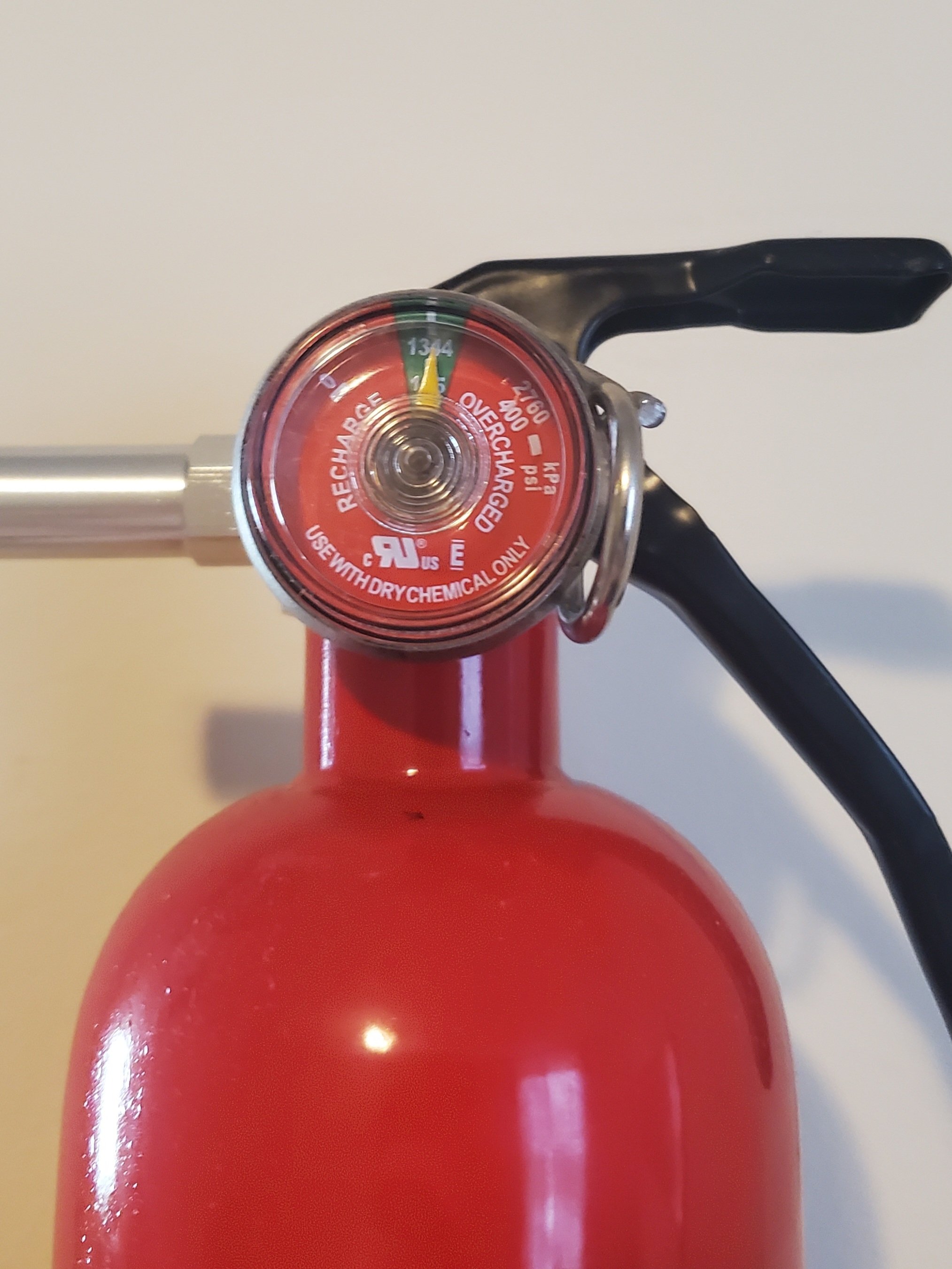
Yes I have 2 of them.
FYI you should turn over each of your fire extinguishers at least once every 6 months to keep them working right. That means pick it up, rotate it upside-down, and let the stuff inside slide to the top, then turn it back over. I learned this from a fire inspector that I had to guide through a datacenter once.
It really depends on the kind of fire extinguisher as to whether that matters. That said, my understanding is that if it is a dry powder that has settled it would be visible on the pressure gauge.
Really, that is about actually checking the pressure gauge every six months. If you tell someone to look, they never will. If you tell someone they have to do something, they might. Its the same logic behind “testing” a smoke alarm. The electronics are simple enough that you would REALLY need to try to damage them (and they are set up to piss you off with incessant beeping when failing anyway). But by pushing the button every six months, you actually check if there is a battery in it and so forth. Rather than hearing it beep in the morning, telling yourself you’ll fix it when you get home, and never doing so.
How does powder settling affect a pressure gauge? There has been no change to the internal pressure of the vessel, the change loose vs compacted powered will not change the volume of materials inside the extinguisher. The only way the pressure should change is if there’s a leak.
It very much depends on the specific materials which is why it is a “let’s not get into this and just say ‘better safe than sorry’” situation but: Even if the powder is settled, it is going to almost immediately get kicked up and re-mixed once you start spraying. Probably don’t test this for yourself for obvious reasons, but that is why a “fresh” can of spray paint will basically always work. It might not be even for the first few sprays but it rapidly becomes even.
Over simplifying (because molecular dynamics and shit) but think of it like a really crowded room. You basically can’t sit down, let alone lie down, if it is crowded enough. And even if you try, someone will nudge you (or kick you) and you will get going.
As the pressure decreases, the settled powder is less likely to be disturbed and you are more likely to wake up from your nap wondering why nobody else is waiting for the new Star Wars with you. And that is why paint cans have the shaker and so forth.
So if your fire extinguisher has settled/compacted to the point that it is not viable? It is almost guaranteed to be because of a pressure leakage and that would be reflected on the gauge.
Now, there is probably some variant where this can happen regardless. But that would be a bad product anyway because these need to work even if nobody can ever be bothered to find the key to the glass box.
Your logic is not correct. Powder and people are not the same. Volume is volume, and particles of fire retardant are not changing size or quantity. If pressure drops substantially in an extinguisher, it’s leaking.
A can of fresh spray paint works because the seals are all still good and the nozzle isn’t clogged, and cans of used spray paint can leak out pressure or have the nozzle or other plumbing jammed up with dried spray paint.
You’re right, the pressure gauge shouldn’t change without a leak or temperature change (Boyle’s Law and such). But it’s hard to have a 100%, no-leak extinguisher. There’s plenty of points of failure to keep the thing pressurized, and the leak could be imperceptible (over months) or a rapid failure
And you wanna keep contents from settling as well, so you don’t just spray gas when trying to use it. So you mix it a bit and inspect the gauge every so often, because you don’t want it to fail when you need it most
Ideally, it shouldn’t lose pressure. But also ideally, you don’t have a fire that requires an extinguisher in the first place
But yes, you’re right on that one. “Settling” of the fire-retardent wouldn’t cause a pressure change. It’s just part of the safety inspection to check the gauge as well as to “mix” it… keeping it ready to go
It’s* the same logic
'Tis*
Those in the biz call it “fluffing” the FE.
TIL, thanks
I have 3. 2 are still pressurized. One was used last night.
A note to everyone…do your welding before you paint and undercoat, or at least wait for it to dry fully first.
Hope it all turned out ok! You’re posting so clearly you survived
Everything is fine. I was welding in the outer rocker when it ignited. It was a brief flash and then it went out. I only used the fire extinguisher because I saw smoke coming from the seatbelt hole near the top of the door. I figured better safe than sorry. Of course now the inside of the rocker that I can’t get to anymore is covered in white powder, but at least it’s kinda fireproof now.
Maybe I am just projecting here, but I believe the average Lemmy user to be too much of a nerd to be welding in their free time. Is it possible to be both Bonehead?
You’re projecting. I weld because I’m a nerd. This job is just helping out a buddy, but before that I was welding a new mount for my trailer hitch snow plow that I built a few years ago. And this summer I want to build a remote control lawnmower which is going to involve a lot of welding, plus some code to reprogram the hoverboards that I bought for that project. The real challenge there will be adding basic intelligence with a Raspberry Pi so that it will mow the lawn itself. But that’s a few years away, since I still need to build it first. And that starts with welding the frame.
It’s not really possible to be both, since one is merely a tool that satisfies the needs of the other. Nerd always takes precedence…
Piggybacking on this PSA to remind everyone;
- Attack the base of the fire, where the fuel source is. You need to break the fire triangle to stop the reaction, and drowning out oxygen is the easiest way.
- Each rated pound of fire extinguisher yields approximately one second of use. They go quickly when you’re fighting any fire, and even small fires fight back. 5lb is the minimum imo, look at any commercial setting where OSHA applies and it’s big 10-20lb tanks generally.
- Trainers advise to blow the whole extinguisher even if flames aren’t visible to prevent auto-ignition.
- You really, really want a hose on any extinguisher. Invert the extinguisher to get under a car/cabinet/low obstacle and the extinguisher is useless as the pressurized gas escapes, leaving behind the powder/foam/water that actually stops fire.
I have four fire extinguishers:
- One in the kitchen
- One in the basement
- One in my office (where I do stuff like soldering and 3D-printing)
- One mounted to the roll bar of my Miata (I ought to get some for my other cars, but haven’t gotten around to making mounting brackets yet)
However, I never would’ve thought to check them (or turn them upside down to “fluff” them) without this post, so thanks!
As a gift to my friends who were going to be first time parents, I bought them a pack and play, a first aid kit, and a fire extinguisher. They laughed at my fire extinguisher gift and told their other friends who also laughed.
Laugh all they want burning alive is a shit way to go. And you might have saved them from that fate.
Just to be pedantic, I think most people who die in building fires perish due to smoke inhalation. Still bad though, and almost completely preventable!
Awh, that’s kind of crappy. I’m hoping they just took it as a gag gift; be prepared for anything, a bit like Jack Jack in The Incredibles.
I hope theynever have to use it, but I hope they do learn how important it is.
Same for cleaning dryer lint; before I was born the entire family who lived across the road from my mum perished in a house fire from dryer lint catching.
Also add Carbon monoxide detectors to that list of devices you never want to need, but should never be without
Dryer lint fires are so strange to me. Cleaning out the lint trap takes less than 5 seconds, and I do it with every load. I pulled the dryer hose off last weekend to clean it, and it was spotless, presumably because I clean the lint from the trap.
Followed by: do you have a functional fire extinguisher in your kitchen and can you reach it immediately?
Stove top fires are usually easy, just put a lid on whatever to put them out, but there’s always going to be someone who panics and dumps water on a grease fire.
Not too immediately. Take 3 steps back/towards the nearest exit, that’s where you want the extinguisher. Not right next to the stove that’s going to be on fire when you need to get to the extinguisher.
Keep in mind that a standard ABC extinguisher isn’t rated for grease fryers. If it’s just the fat needed to sautee something you’re good, but for an actual deep frying fire you want something in class K.
Absolutely it is one of these products that you probably never need. But when you do you are so happy you had it standing around.
I do routine inspections once a year when I do my fire alarm testing so every time I switch to daylight saving time.
Just caused an oil fire last week and fortunately it was working. I’ve since replaced also.
I’m a professional fire performer, so I have four :P
(Admittedly two need refilling)
Those years of safety training finally paying off:
Do you know what types of fires your fire extinguisher is rated for? There are several different types. Most modern home fire extinguishers are rated for A (wood/paper), B (liquids like oil fires), and C (electrical), but you may have an older fire extinguisher or landlord who cheaped out on one that only works on some of those types.
If you have a fire that’s based on metals (like fireworks) or exothermic chemical reactions, have a different fire extinguisher or call the fire department with special instructions.
Always remember the acronym PASS when using a fire extinguisher:
- Pull the pin
- Aim at the base of the fire
- Squeeze the trigger
- Sweep the fire extinguisher side to side to cover all of the fire till the fire is extinguished
If you have a fire that’s based on metals (like fireworks) or exothermic chemical reactions, have a different fire extinguisher or call the fire department with special instructions.
It ought to go without saying, but maybe not for some, so it’s worth pointing out that there’s a difference between a fire started by fireworks and one fueled by fireworks.
Great point! So if you have a firework that sparks some dry grass or brush, your home fire extinguisher will likely be fine as long as the fire doesn’t get too big before you can grab it.
However, if you have a hoard of fireworks that catch fire, you’re better off running and calling the fire department than trying to quickly put that out with your home fire extinguisher as it likely won’t work.
My extensive training has left me with the impression that yelling “SHORT BURST” and pointing at any red LEDs is equally important
Yup. We had one but after we had a smouldering fire in our outdoor trash can we got several for different points in the house. We also have escape ladders in the bedrooms.
After being directly adjacent to three separate apartment fires, we also have several fire extinguishers and escape ladders stashed around the apartment.
Fire blankets are good to have as well
Nope, don’t even have a fire alarm.
I am sure the insurance company loves you.
Falls asleep with a cigarette in his mouth every night
Got to make sure you put a lit candle down on top of your oil soaked news papers. Otherwise they’ll blow away.
I don’t remember them even asking for either one.
That tends to be covered by code.
if ANYTHING happens in your home and they either send someone out or a responder makes a note of it, you get dropped and they laugh.
Yup, but neither is required by code where I live.
Some insuraners offer a small discount for having a fire alarm, but they can’t drop you for not having one.
So it’s not my business but I’m curious… You can get smoke detectors for like $10/each, you seen to acknowledge that having 0 smoke detectors is kinda dangerous… why not install a couple smoke detectors? I always thought they were annoying until a Chinese cheap battery self ignited in the next room while I was sleeping, it would’ve burned my apartment building down if there wasn’t a smoke detector in the room.
I used to live in Germany where smoke detectors where mandatory at some point. It was also the landlords responsibility. So what you had was a some company coming into your home once a year to check all the smoke detectors. I found that to be very intrusive.
Not sure of this process has been digitised since (in Germany probably not), but I don’t really miss it. (I live in Switzerland now, and here smoke detectors are not required by anyone (might depend on Canton)).
You don’t need anyone to come inspect anything. It’s literally a small plastic device you can buy online or at a store, put a battery in, and forget it exists until it tells you it needs a new battery or it saves your life.
When it’s required and the landlord’s responsibility, they’re liable if a fire happens and the detectors don’t do their job. So they’re gonna send someone out periodically to make sure it’s still functioning properly. There’s nobody there to check yours if you just buy your own.
Seriously, if that’s your only hold up, please get some smoke detectors in your house. Having smoke detectors isn’t something that you “miss”, it’s something that you hope you never have to have needed but the one time you do need it, it can save your life, your loved one’s lives, everything you own.
deleted by creator
And synced smoke alarms
Same. Also, they are both smoke and heat alarms so they also trigger for smokeless fires. They are also linked into my home automation system, if triggered every light in the house will turn on to maximum brightness. It will also send an alert to my phone.
deleted by creator
Wouldn’t know, never used it. I tend to stay away from anything written in python as much as I can.
deleted by creator
Some languages are much more difficult to write reliable and stable code in, especially for larger codebases. Python is one of those. I’m not saying it can’t be done, but that’s despite the language being used, not thanks to it.
My home runs on OpenHAB, which is written in Java and built on top of OSGi.
When I set up my home automation (which was years ago) I looked into the technical aspects of the different options and OpenHAB had by far the most solid architecture.
deleted by creator
To my experience, writing reliable code is more about the coding strategy than anything else, the language used doesn’t even make the list. And I’ve developed with pascal back in the day.
Language makes a lot of difference in my experience. For example: a good type system can eliminate entire classes of mistakes. In Swift for example there are optional types, Non-optional types can never be
niland for optional types you have to explicitly deal with the possibility of a variable beingnil. Boom, null-pointer error are a thing of the past, enforced by the compiler. One less thing to worry about.
why?
It’s very difficult to write and maintain any significant amount of code in a ducktyped language. I don’t trust python code to be reliable or stable. It’s a nice toy language for academic projects but in no way suitable for production use. I certainly won’t have it controlling the things in my home that should just work, like the lights.
There is plenty of production code written and maintained in Python outside of academia, as well as Perl, PHP and others. You’re presenting an opinion as fact.
I’m not saying it can’t be done, only that it’s not a good idea.
what’s is ducktyped
In most programming languages data has a type. You can think of it as the ‘shape’ of the data. For example: you have an ‘integer’ type which can contain whole numbers, a ‘floating point’ type which can contain fractional numbers, a ‘string’ type which can contain text, etc.
These simple types are called ‘primitive’ types, they are built into the language itself.
Usually, you can also define your own types, which are made up of the primitive types, for example: you can have a ‘car’ type:
class Car { float maximumSpeed; int numberOfPassengers; String brand; String model; }Meaning any piece of data of type ‘Car’ has a maximum speed, number of passengers, brand an model.
Now languages like Java have so called static typing. You declare something to be a car, and the compiler knows that a car has these properties. This is used in a lot of places. Variables have types, parameters passed to a function have types. The return values of functions have types, etc. Static typing means you always know exactly what type of data you are dealing with.
Ducktyping is the exact opposite. The term comes from ‘if it walks like a duck and quacks like a duck, it’s probably a duck’. In a ducktyped language you don’t declare what type something is, you just use the data as if you know what type it is, and if it’s the correct type, it works. If it’s not, things might break.
In a statically typed language it is impossible to use the wrong type, this is enforced by the compiler. In a ducktyped language this is impossible, as the types are not declared. So if a function expects a ‘Car’ as a parameter, and you pass in a ‘Horse’ instead, in Java you would get an error when trying to compile this code. In Python it would just run it. This may be fine. A horse may also have a maximumSpeed and if you try to read that it would work. But when you try to access something a Horse doesn’t have, like the ‘brand’ property, things go tits up.
The main problem with this is that you only see this if you happen to run that specific bit of code in that specific situation. It may never happen during testing. Worse, if you change anything in ‘Car’ you don’t necessarily catch all the problems this causes. Say you rename ‘numberOfPassengers’ to ‘passengerCount’, in Java any code that still tried to access ‘numberOfPassengers’ would fail to compile, you’d immediately get an error. In Python you wouldn’t spot this problem at all until it’s too late.
The advantage of ducktyping is that it’s less verbose, you can whip something together quickly without having to think too much about the types. For a small simple program this is perfect, but the larger your codebase gets the harder it becomes to manage this. You can’t oversee the whole codebase anymore, mistakes happen and the compiler won’t catch them.
You can mitigate it a little, for example by writing lots of automated tests, but you really shouldn’t have to. A static type system prevents a lot of dumb mistakes from being made.
Currently have 6. I need to get more, and larger ones. We live in a log house, in an area that takes a minimum of 20 minutes for emergency services to get to, and heat with a wood stove. We absolutely need to practice fire safety all the time.
Oh man, definitely get more!
That’s the idea. The really big ones get pretty expensive though; a 30# fire extinguisher starts at around $500, and can get up to about $1500. But that size gets you about 20-30 seconds of continuous use, which is enough for a pretty big house fire.
I don’t use permanently pressurized fire extinguishers anymore, as they are hard to maintain and rarely reach a life span of 20 years.
Make sure to check at least once every 3 years if the pressure is still in the green. If not, replace it immediately.
Can they be repressurized at all with a regular pump? Or is it something more in depth than that
If you look at the gauge, you can see that the ideal pressure is 1344 kPa or 13.44 bar. If you own a pump capable of using at least 14 bar, you are good to go.








